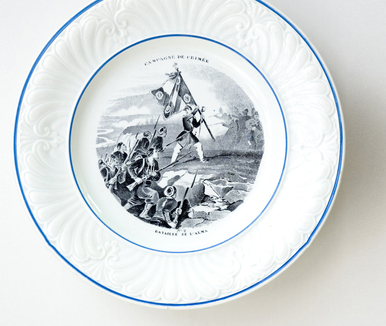The round decorative plate with wide sides in lettuce green color was made in Great Britain. The bottom of the product is decorated with a drawing: the artist depicted Scottish soldiers leaving for the Crimean War and saying goodbye to their families.
In the foreground, the artist painted a family with three children. A soldier in a traditional plaid skirt is holding his youngest child, his wife is standing next to him. She is dressed in a long skirt, plaid cape and a hat. On the other side of the soldier is his daughter. Her posture expresses sadness: the girl lowered her head and folded her hands under her chin.
On the right, the master depicted the Scottish warriors, who lined up in columns. On the left are those seeing them off, some waving their hats.
Scottish troops were sent from the English town of Plymouth to the Crimea in the spring of 1854. Balaklava was the main base for the Allies first, and then the forces were distributed: the French positioned themselves under Sevastopol, the British covered the main siege camp and Balaklava with its harbor.
The Scottish regiments became part of the 1st Guards Division of General Adolf of Cambridge, as well as the 42nd, 79th and 93rd regiments, which participated in the Alma, Inkerman and Balaklava battles.
The Battle of Balaklava began in October 1854, at about five in the morning. At the beginning of the battle, Russian troops in a bayonet attack drove the Turks out of the first fortification — the redoubt. The Turks left the other three redoubts without a fight.
Next, General Pavel Petrovich Liprandi moved the Hussar brigade of Lieutenant General Ivan Ivanovich Ryzhov to attack — it was to destroy the artillery of the British. Instead, however, the Russians faced a heavy British cavalry unit. This came as a surprise to both sides. A fierce battle ensued and the British cavalry retreated. However, Ryzhov’s brigade also returned to their original positions —on the original order of General Liprandi.
At the same time, the 1st Ural Cossack Regiment of Lieutenant Colonel Mikhail Pavlovich Khoroshkhin attacked the 93rd Scottish Infantry Regiment. The forces were unequal, but the regiment withstood, and this feat brought him fame.
By the end of the battle near Balaklava the enemies remained in their initial positions. Russian troops were unable to destroy the British camp and disrupt the supplies of the troops who were besieging Sevastopol. But the plans of the allies for a quick siege of the city also did not come true.
In the foreground, the artist painted a family with three children. A soldier in a traditional plaid skirt is holding his youngest child, his wife is standing next to him. She is dressed in a long skirt, plaid cape and a hat. On the other side of the soldier is his daughter. Her posture expresses sadness: the girl lowered her head and folded her hands under her chin.
On the right, the master depicted the Scottish warriors, who lined up in columns. On the left are those seeing them off, some waving their hats.
Scottish troops were sent from the English town of Plymouth to the Crimea in the spring of 1854. Balaklava was the main base for the Allies first, and then the forces were distributed: the French positioned themselves under Sevastopol, the British covered the main siege camp and Balaklava with its harbor.
The Scottish regiments became part of the 1st Guards Division of General Adolf of Cambridge, as well as the 42nd, 79th and 93rd regiments, which participated in the Alma, Inkerman and Balaklava battles.
The Battle of Balaklava began in October 1854, at about five in the morning. At the beginning of the battle, Russian troops in a bayonet attack drove the Turks out of the first fortification — the redoubt. The Turks left the other three redoubts without a fight.
Next, General Pavel Petrovich Liprandi moved the Hussar brigade of Lieutenant General Ivan Ivanovich Ryzhov to attack — it was to destroy the artillery of the British. Instead, however, the Russians faced a heavy British cavalry unit. This came as a surprise to both sides. A fierce battle ensued and the British cavalry retreated. However, Ryzhov’s brigade also returned to their original positions —on the original order of General Liprandi.
At the same time, the 1st Ural Cossack Regiment of Lieutenant Colonel Mikhail Pavlovich Khoroshkhin attacked the 93rd Scottish Infantry Regiment. The forces were unequal, but the regiment withstood, and this feat brought him fame.
By the end of the battle near Balaklava the enemies remained in their initial positions. Russian troops were unable to destroy the British camp and disrupt the supplies of the troops who were besieging Sevastopol. But the plans of the allies for a quick siege of the city also did not come true.



